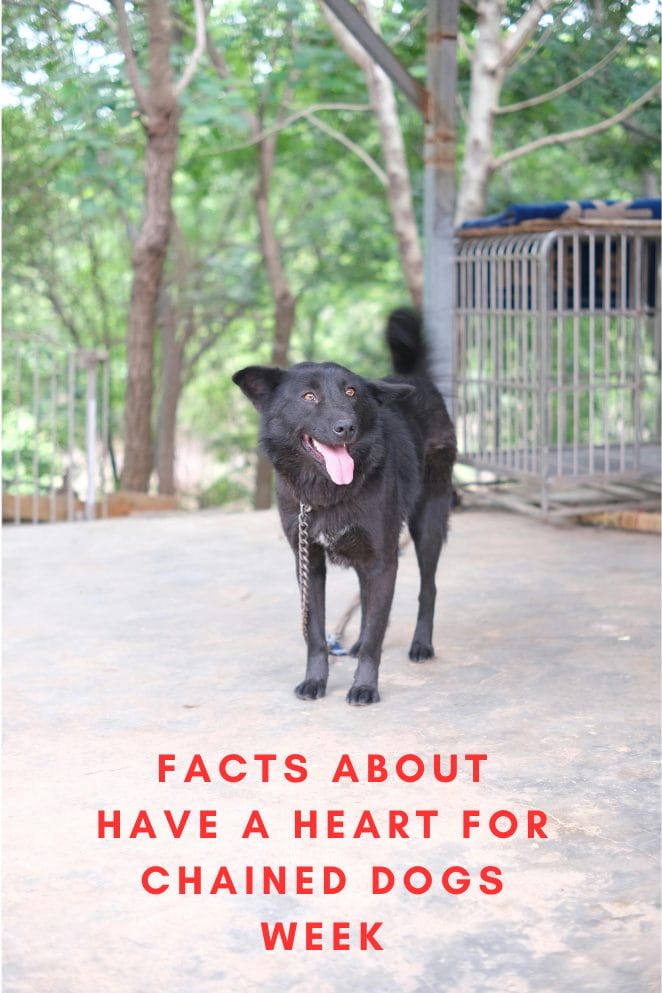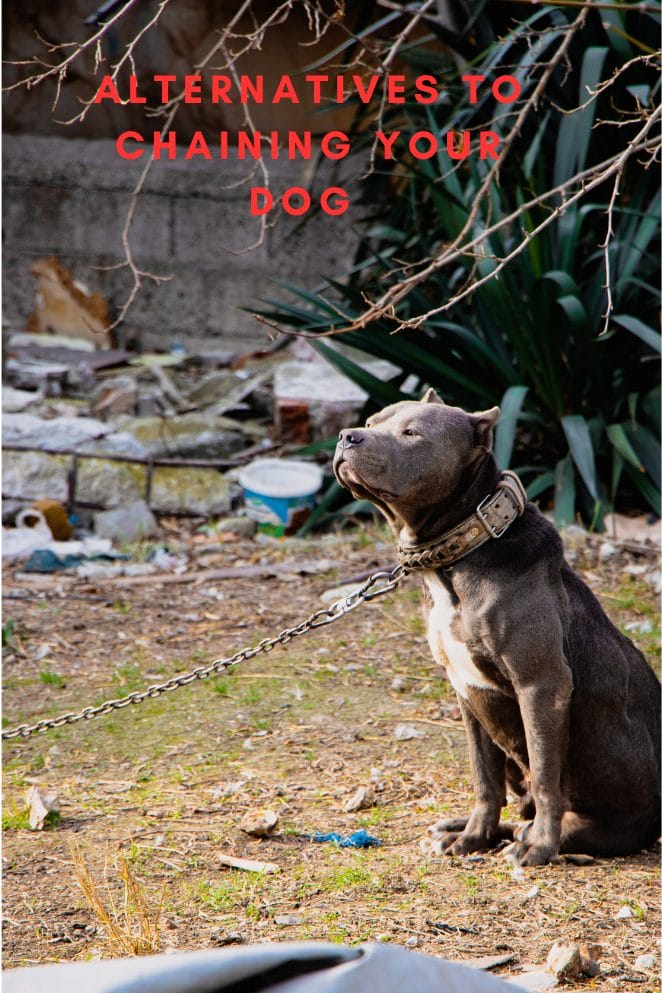
From February 7 to 14, we observe “Have a Heart for Chained Dogs Week.”
This Valentine’s Day, prepare to experience the most genuine form of love imaginable.
The terms ‘chaining’ or ‘tethering’ refer to the practice of securing a dog to a stationary object for control purposes.
Regrettably, this practice is deemed cruel, as it poses significant threats to the physical and psychological well-being of our canine companions.
History Of Have A Heart For Chained Dogs Week

Although dogs are a person’s best friend, alas, people aren’t always dog-friendly.
Dogs have repeatedly shown their commitment to us, but some people don’t give them the affection they need. So, let’s give our dogs lots of love and affection in return for their friendship.
In 2002, Tammy Grimes established Dogs Deserve Better, a non-profit organization in Virginia.
After being arrested for saving a caged puppy that was dying, she founded the group.
To bring attention to the predicament of abandoned dogs, Dogs Deserve Better launched the Have a Heart for Chained Dogs campaign.
Chained dogs often fade into the background, enduring neglect that takes a toll on their well-being.
Those confined to chains outdoors endure deplorable conditions, lacking sufficient food, shelter, and at times, even access to clean water.
Prolonged periods of chaining deny dogs the vital companionship of humans or their fellow canines.
Dogs, inherently social creatures, suffer from being tethered, leading to various behavioral issues, profound loneliness, and an instinctual overprotectiveness of their limited territories.
Additionally, tethered dogs face heightened risks of injuries or, tragically, death, unable to escape when confronted by other animals.
The repercussions of chaining extend beyond the physical realm, affecting the mental and emotional health of these loyal companions.
Dogs Deserve Better raises awareness of the mistreatment that dogs endure while they are confined to a leash around Valentine’s Day each year.
Instead of accusing, their intention is to educate people so they will think twice before bringing their dog inside or finding a better home for it.
Facts About Have A Heart For Chained Dogs Week

Children attacked by chained dogs
Between October 2003 and January 2007, 112 children were killed or gravely injured by tethered dogs, according to Dogs Deserve Better.
The proportion of attacks by tethered dogs
A quarter of all fatal dog attacks, according to the book “Fatal Dog Attacks,” were caused by chained dogs.
Existing in chains
Tragically, 200,000 canines spend their entire lives tethered or chained outside.
They are exposed since they are shackled.
Dogs that are chained are more susceptible to animal assaults.
They pose a greater risk.
Dogs on chains are 2.8 times more likely to bite, according to research from the Centres for Disease Control and Prevention.
Why Have a Heart For Chained Dogs Week Is Important?

It defends the rights of canines
To raise awareness of the suffering of abandoned dogs that are left outside unattended for extended periods, Dogs Deserve Better was founded on this day.
It’s an attempt to support chained dogs, who are susceptible to a range of physical and psychological harm, and to have them welcomed and let into households.
An attempt is made to educate
On this day, people learn about the risks that pets that are left unattended outside face. Without placing blame, the goal is to raise awareness of how traumatizing it is for these pets.
We love dogs
Dogs are deserving of all of our affection. They bring endless quantities of love and affection into our lives; they are the gentlest and kind animals. We shouldn’t compensate them for their devotion and loyalty by chaining them outside.
How To Observe Have A Heart For Chained Dogs Week?

Bring your canine inside.
Dogs are highly gregarious animals, and much like people, they become bored and lonely when left outside on their own. Bring them inside so they may interact with others and become a member of the family.
Observe your dog’s needs.
Dogs need to be physically active for extended periods of time in order to relax.
To provide your dog with some independence, build a fence in your backyard, give them chew toys, and take them for regular walks.
If required, train your dog in obedience to help him become a well-mannered indoor dog. Maintaining these three essentials will go a long way toward controlling your dog’s behaviour.
Volunteer for your neighbourhood dogs
Help pets in your neighborhood by volunteering. Introduce yourself to the dog’s caretakers and volunteer to walk chained canines. Make a call to your local police department, humane society, or animal control office if you are worried about someone else’s chained dog.
Alternatives to Chaining Your Dog

The Humane Society has provided 5 excellent tips that are a perfect substitute for chaining your dog.
- Install a 45-degree inward extension to the highest point of your current fence if your dog can jump over it. These extensions are sold in a lot of home improvement stores.
- Bury chicken wire one foot below the surface where the barrier meets the surface of the earth (be sure that you bend in the sharp edges) in case your dog digs under the fence to get out of your yard. Alternately, put big rocks at the fence’s base.
- Should the two aforementioned solutions prove ineffective for your “escape artist,” contemplate employing an electronic fence or a cable runner.
- Although they’re not ideal, these choices will provide your dog with greater independence.
- Make sure you only utilize these choices if your dog is fenced in and safe from people and other animals. Consider installing a DIY Dog Treadmill to keep your pup active.
- You should think about constructing plastic garden fencing or a comparable barrier around your dog’s digging areas, such as flower beds or gardens if you don’t want him to dig there.
- Alternatively, give your dog a sandbox of his own. Use positive reinforcement to teach your dog that it’s acceptable to dig in the sandbox by hiding toys there.
- Behaviour issues including digging, gnawing, and barking are frequently brought on by insufficient stimulus.
With the right toys, exercise, “people time,” and encouragement from other dogs, you can change bad habits and teach your dog appropriate house manners.
Furthermore, a dog inside the home has a far higher chance of preventing an intruder than a dog that is tethered outside.
Conclusion
Have a Heart for Chained Dogs will be held from February 7–14. Week Ending raises awareness to how frequently dogs are chained.
The intention is to end dogs being constantly chained.
Although they strive to achieve this goal throughout the year, one of their busiest times of the year is the week leading up to Valentine’s Day.
It draws attention to canines that are handled more like imprisoned prisoners of war than as household pets.
Dogs that are left in outdoor enclosures or tethered outside all the time suffer from mental and physical problems.
—————————–


GIPHY App Key not set. Please check settings